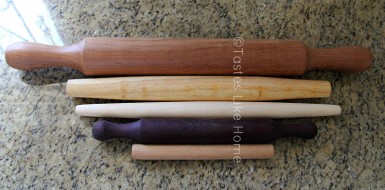Hi Everyone, There are many cooking utensils that get passed down from one generation to the next – masala bricks, mortars and pestles, pots, pans and rolling pins too. In most cases we hold on to these for nostalgia while others we continue to use regularly because they do a perfect job for us, every time! Such is the case with rolling pins.
Whether they are made of glass, silicone, plastic, marble or wood, rolling pins are an indispensable kitchen utensil.
A rolling pin (belnah in Guyanese parlance) is a cylindrical utensil used to shape and flatten dough. While the materials used to make them are many, rolling pins basically come in 2 styles – rollers and rods. The rollers are the ones that come with handles attached or the ones to which we are accustomed – the handles are cut and shaped on both ends of the rolling pin. Rods are the ones that look more like batons with both ends being tapered. There are some rod-pins that are not tapered at all – from left to right it’s one size with one width all around.
 Many cooks will tell you that they have favourite pots, pans, spoons and spatulas that they use all the time, and to make specific things. It is the same with rolling pins. Here’s the thing, utensils that we use with our hands are an extension of our own hands, therefore having the right fit and feel while executing many tasks is of utmost importance.
Many cooks will tell you that they have favourite pots, pans, spoons and spatulas that they use all the time, and to make specific things. It is the same with rolling pins. Here’s the thing, utensils that we use with our hands are an extension of our own hands, therefore having the right fit and feel while executing many tasks is of utmost importance.
 I have 5 rolling pins. I know, it might seem like a bit of an overkill, but trust me, I use them all when making certain things and working with various types of dough. All are wooden (different grains and types of wood; my preferred material for rolling pins). My most recent acquisition was in Guyana in June of this year. I had one custom-made. I bought a larger tawah than the one I have, and therefore needed a rolling pin with a wider barrel. Apart from that, I was also a little weary of rolling certain dough to widths and lengths beyond my previous rollers only to have the dough uneven in thickness. Sometimes this resulted in the dough being worked too much and me not getting a proper feel of how hard I am pressing down. With this new rolling pin, I can make larger roti(s), and therefore, spend less time in the kitchen I don’t have to worry about uneven dough – pastry and otherwise.
I have 5 rolling pins. I know, it might seem like a bit of an overkill, but trust me, I use them all when making certain things and working with various types of dough. All are wooden (different grains and types of wood; my preferred material for rolling pins). My most recent acquisition was in Guyana in June of this year. I had one custom-made. I bought a larger tawah than the one I have, and therefore needed a rolling pin with a wider barrel. Apart from that, I was also a little weary of rolling certain dough to widths and lengths beyond my previous rollers only to have the dough uneven in thickness. Sometimes this resulted in the dough being worked too much and me not getting a proper feel of how hard I am pressing down. With this new rolling pin, I can make larger roti(s), and therefore, spend less time in the kitchen I don’t have to worry about uneven dough – pastry and otherwise.
It is important to consider certain things when buying a rolling pin. Start by determining how you will be using your rolling pin. Depending on the use(s), you, like me, can end up with more than one rolling pin. However, if you do not cook and experiment as often as I do then I’d say a good all-purpose rolling pin would be just fine. Or, get two, one of each kind, a roller – with handles (preferably the ones that the handles are carved just off of the barrel) and a rod, choose between one with tapered ends or without the ends tapered.
Considerations
Materials
As I have said before, rolling pins come in various materials and the full range is – glass, ceramic, acrylic, copper, brass, aluminium, silicone, wood, stainless steel, marble and plastic. With each material comes a different property in terms of weight and size, but we’ll get to that later. People choose rolling pins made of certain materials because it enables them to operate with ease when working with certain types of dough. For example, many prefer a marble rolling pin when working with laminated (pastry) dough. This is the type of dough that is used to make puff pastry, Danish and croissants. The rolling pin is chilled to help maintain the coolness of the pastry and the material reacts well with the high-butter-content dough. An added bonus is that because the marble is heavy, it means that you do not have to exert a lot of force when rolling and the weight of the rolling pin would do the work. This will ultimately result in the dough not being overworked.
- Rolling pins made with silicone barrels help keep dough from sticking to the pin and thus minimises and on occasion eliminates the amount of flour needed for rolling dough.
- Glass and metal barrel rolling pins are usually hollow. When used, they are filled with cold water or ice; this is done to keep the dough chilled, as it is being smoothed, shaped and flattened.
- The type of finish given to wooden rolling pins is to be considered. Actually, it is a combination of the finish and the grain of the wood itself. Some are sanded so smoothly (and lightly varnished) that they cannot take a dusting of flour. In other words, the surface is so smooth that when you rub the barrel with a little flour (as is often suggested in recipes), none of the flour adheres to the rolling pin. I would suggest that you go for one that is very slightly textured and can hold a dusting of flour. Don’t worry, the texture wouldn’t show up on your dough.
- There is another type of rolling pin – textured pins – that have designs and artwork engraved on them, all around the barrel. These are used when making specialized dough, cookies, breads and ravioli.
Weight & Size
The weight of a rolling pin is determined by 2 things – the material with which it is made and the size (width).
A heavy rolling pin can be a good and a bad thing – too heavy and it quickly begins to hurt your hands and become cumbersome to use. It can easily tear the dough and end up mashing rather than rolling, stretching, and shaping it. The right weight can mean that you do not have to use a lot of force to smooth out the dough. It means that you can spend less time working the dough but getting it to where you need it with fewer strokes.
Wide barrels also help to minimise how much the dough needs to be worked. Think about it. If the barrel – the long smooth piece in the middle – is wide then you don’t have to keep rolling the dough over and over and over to get it as long or wide as you wish. Or as evenly.
When thinking of the size of a rolling pin (more so if you are getting one custom made) measure your hand-spread (that’s my terminology). In other words, spread your hands out on your typical work surface to ascertain the width of your hands when spread and using the rolling pin. Wherever your hands land comfortably, that should be where the handles are. Too wide or too narrow can cause discomfort and pain in your hands and wrist.
So whether you are making pasta, pita or pizza, pastries and puri or lavash and lefse, choose a rolling pin that is right for you and keep on rolling. Don’t beat anybody though!
(Inbox me: [email protected] for details of where I got my rolling pin custom made in Guyana).
Cynthia
www.tasteslikehome.org





